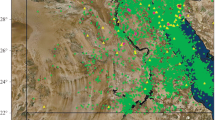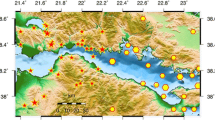Abstract
The complexity of seismogenesis requires the development of stochastic models, the application of which aims to improve our understanding on the seismic process and the associated underlying mechanisms. Seismogenesis in the Corinth Gulf (Greece) is modeled through a Constrained-Memory Stress Release Model (CM-SRM), which combines the gradual increase of the strain energy due to continuous slow tectonic strain loading and its sudden release during an earthquake occurrence. The data are treated as a point process, which is uniquely defined by the associated conditional intensity function. In the original form of the Simple Stress Release Model (SSRM), the conditional intensity function depends on the entire history of the process. In an attempt to identify the most appropriate parameterization that better fits the data and describes the earthquake generation process, we introduce a constrained “\(m\)-memory” point process, implying that only the \(m\) most recent arrival times are taken into account in the conditional intensity function, for some suitable \(m \in N\). Modeling of this process is performed for moderate earthquakes (M ≥ 5.2) occurring in the Corinth Gulf since 1911, by considering in each investigation different number of steps backward in time. The derived model versions are compared with the SSRM in its original form and evaluated in terms of information criteria and residual analysis.





Similar content being viewed by others
References
Akaike H (1974) A new look at the statistical model identification. IEEE Trans Autom Control 19(6):716–723
Aristotle University of Thessaloniki Seismological Network (1981). Permanent Regional Seismological Network operated by the Aristotle University of Thessaloniki. International Federation of Digital Seismograph Networks, Other/Seismic Network, DOI:10.7914/SN/HT
Armijo R, Meyer B, King GCP, Rigo A, Papanastassiou D (1996) Quaternary evolution of the Corinth Rift and its implications for the late Cenozoic evolution of the Aegean. Geophys J Int 126:11–53
Bebbington M (2005) Information gains for stress release models. Pure Appl Geophys 162:2229–2319
Bebbington M, Harte D (2001) On the statistics of the linked stress release process. J Appl Probab 38:176–187
Bebbington M, Harte D (2003) The linked stress release model for spatio-temporal seismicity: formulations, procedures and applications. Geophys J Int 154:925–946
Bernard P, Briole P, Meyer B, Lyon-Caen H, Gomez M, Tiberi C, Berge C, Cattin R, Hatzfeld D, Lachet C, Lebrun B, Dechamps A, Courbouleux F, Larroque C, Rigo A, Massonnet D, Papadimitriou P, Kassaras J, Diagourtas D, Makropoulos K, Veis G, Papazisi E, Mitsakaki C, Karakostas V, Papadimitriou E, Papanastasiou D, Chouliaaras M, Stavrakakis D (1997) The Ms =6.2, June 15, 1995 Aigion earthquake (Greece): evidence for low angle normal faulting in the Corinth rift. J Seismol 1:131–150
Bray A, Schoenberg FP (2013) Assessment of point process models for earthquake forecasting. Stat Sci 28:510–520
Briole P, Rigo A, Lyon-Caen H, Ruegg JC, Papazissi K, Mitsakaki C, Balodimou A, Veis G, Hatzfeld D, Deschamps A (2000) Active deformation of the Corinth rift, Greece: results from repeated Global Positioning surveys between 1990and1995. J Geophys Res 105:25605–25625
Bufe C, Varnes D (1993) Predictive modeling of the seismic cycle of the greater San Francisco bay region. J Geophys Res 98:9871–9883
Burnham KP, Anderson DR (2002) Model selection and multimodel inference: a practical information-theoretic approach, 2nd edn. Springer, New York
Chousianitis K, Ganas A, Evangelidis CP (2015) Strain and rotation rate patterns of mainland Greece from continuous GPS data and comparison between seismic and geodetic moment release. J Geophys Res. https://doi.org/10.1002/2014JB011762
Console R, Murru M, Lombardi AM (2003) Refining earthquake clustering models. J Geophys Res 108:2468
Daley D, Vere-Jones D (2003) An introduction to the theory of point processes, vol 1, 2nd edn. Springer, New York, p 469
Davoudi N, Tavakoli HR, Zare M, Jalilian A (2018) Declustering of Iran earthquake catalog (1983-2017) using the epidemic-type aftershock sequence (ETAS) model. Acta Geophys 66:1359–1373. https://doi.org/10.1007/s11600-018-0211-5
Engle RF, Russell JR (1998) Autoregressive conditional duration: a new model for irregularly spaced transaction data. Econometrica 66:1127–1162
Fletcher R (1987) Practical methods of optimization, 2nd edn. Wiley, New York, p 456
Ganas A, Chousianitis K, Batsi E, Kolligri M, Agalos A, Chouliaras G, Makropoulos K (2013) The January 2010 Efpalion earthquakes (Gulf of Corinth, Central Greece): earthquake interactions and blind normal faulting. J Seismol 17:465–484
Harte DS, Vere-Jones D (2005) The entropy score and its uses in earthquake forecasting. Pure Appl Geophys 162:1229–1253
Hatzfeld D, Karakostas V, Ziazia M, Kassaras I, Papadimitriou E, Makropoulos K, Voulgaris N, Papaioannou C (1996) The Galaxidi earthquake of 18 November 1992; a possible asperity within normal fault system of the Gulf of Corinth (Greece). Bull Seismol Soc Am 86(6):1987–1991
Hatzfeld D, Karakostas V, Ziazia M, Kassaras I, Papadimitriou E, Makropoulos K, Voulgaris N, Papaioannou C (2000) Microseismicity and faulting geometry in the Gulf of Corinth. Geophys J Int 141:438–456
Hawkes AG (1971) Spectra of some self-exciting and mutually exciting point processes. Biometrika 58:83–90
Hawkes AG, Oakes D (1974) A cluster process representation of a self-exciting process. J Appl Probab 11:493–503
Hubert A, King G, Armijo R, Meyer B, Papanastassiou D (1996) Fault re–activation, stress interaction and rupture propagation of the 1981 Corinth earthquake sequence. Earth Planet Sci Lett 142:573–585
Hurvich CM, Tsai C-L (1989) Regression and time series model selection in small samples. Biometrika 76(2):297–307. https://doi.org/10.1093/biomet/76.2.297
Imoto M, Hurukawa N (2006) Assessing potential seismic activity in Vrancea, Romania, using a stress-release model. Earth Planets Space 58:1511–1514
Jackson JA, White NJ (1989) Normal faulting in the upper continental crust: observations from regions of active extension. J Struct Geol 11:15–36
Jackson J, Cagnepain A, Houseman JG, King GCP, Papadimitriou P, Soufleris C, Virieux J (1982) Seismicity, normal faulting and the geomorphological development of the Gulf of Corinth (Greece): the Corinth earthquakes of February and March 1981. Earth Planet Sci Lett 57:377–397
Karakostas V, Karagianni E, Paradisopoulou P (2012) Space-time analysis, faulting and triggering of the 2010 earthquake doublet in western Corinth Gulf. Nat Hazard 63:1181–1202
Karakostas V, Mirek K, Mesimeri M, Papadimitriou E, Mirek J (2017) The aftershock sequence of the 2008 Achaia, Greece, Earthquake: joint analysis of seismicity relocation and persistent scatterers interferometry. Pure Appl Geophys 174:151–176
King GCP, Ouyang ZX, Papadimitriou P, Deschamps A, Gagnepain J, Houseman G, Jackson JA, Soufleris C, Virieux J (1985) The evolution of the Gulf of Corinth (Greece): an aftershock study of the 1981 earthquakes. Geophys J R Astron Soc 80:677–693
Kuehn NM, Hainzl S, Scherbaum F (2008) Non-Poissonian earthquake occurrence in coupled stress release models and its effect on seismic hazard. Geophys J Int 174:649–658
Lewis PAW, Shedler GS (1979) Simulation of non homogeneous Poisson processes by thinning. Naval Res Logist Q 26:403–413
Liu J, Vere-Jones D, Ma L, Shi Y, Zhuang JC (1998) The principal of coupled stress release model and its application. Acta Seismol Sin 11:273–281
Liu C, Chen Y, Shi Y, Vere-Jones D (1999) Coupled stress release model for time-dependent seismicity. Pure Appl Geophys 155:649–667
Lu C, Vere-Jones D (2000) Application of linked stress release model to historical earthquake data: comparison between two kinds of tectonic seismicity. Pure Appl Geophys 157:2351–2364
Lu C, Harte D, Bebbington M (1999) A linked stress release model for historical Japanese earthquakes: coupling among major seismic regions. Earth Planets Space 51:907–916
Mangira O, Vasiliadis G, Papadimitriou E (2017) Application of a linked stress release model in Corinth gulf and Central Ionian Islands (Greece). Acta Geophys 65:517–531. https://doi.org/10.1007/s11600-017-0031-z
Mangira O, Console R, Papadimitriou E, Vasiliadis G (2018) A restricted Linked Stress Release Model (LSRM) for the Corinth gulf (Greece). Tectonophysics 723:162–171
Marzocchi W, Lombardi AM (2009) Real-time forecasting following a damaging earthquake. Geophys Res Lett 36:L21302
Mesimeri M, Karakostas V, Papadimitriou E, Schaff D, Tsaklidis G (2016) Spatio-temporal properties and evolution of the 2013 Aigion earthquake swarm (Corinth Gulf, Greece). J Seismol 20:595–614
Mesimeri M, Karakostas V, Papadimitriou E, Tsaklidis G, Jacobs K (2018) Relocation of recent seismicity and seismotectonic properties in the Gulf of Corinth (Greece). Geophys J Int 212(2):1123–1142
Meyer S, Elias J, Höhle M (2012) A space-time conditional intensity model for invasive meningococcal disease occurrence. Biometrics 68:607–616
Mohler GO, Short MB, Brantigham PJ, Schoenberg FP, Tita GE (2011) Self-exciting point process modeling of crime. J Am Stat Assoc 106(493):100–108. https://doi.org/10.1198/jasa.2011.ap09546
Ogata Y (1981) On Lewis’s simulation method for point processes. IEEE Trans Inf Theory IT27:23–31
Ogata Y (1988) Statistical models for earthquake occurrences and residual analysis for point processes. J Am Stat Assoc 83:9–27
Ogata Y (1998) Space-time point-process models for earthquake occurrences. Ann Inst Stat Math 50:379–402
Pacchiani F, Lyon-Caen H (2010) Geometry and spatio-temporal evolution of the 2001 Agios Ioanis earthquake swarm (Corinth Rift, Greece). Geophys J Int 180:59–72
Papanikolaou DJ, Royden LH (2007) Disruption of the Hellenic arc: late Miocene extensional detachment faults and steep Pliocene-Quaternary normal faults—Or what happened at Corinth? Tectonics 26:TC5003. https://doi.org/10.1029/2006TC002007
Papazachos BC, Papazachou CC (2003) The earthquakes of Greece. Ziti Publications, Thessaloniki
Reid H (1910) The mechanics of the earthquake, The California earthquake of April 18, 1906. Report of the state investigation commission, vol 2. Carnegie Institution of Washington, Washington, DC, pp 16–28
Rotondi R, Varini E (2006) Bayesian analysis of marked stress release models for time-dependent hazard assessment in the western Gulf of Corinth. Tectonophysics 423:107–113
Rotondi R, Varini E (2007) Bayesian inference of stress release models applied to some seismogenic zones. Geophys J Int 169:301–314
Schoenberg FP (2003) Multidimensional residual analysis of point process models for earthquake occurrences. J Am Stat Assoc 98:789–795
Sokos E, Zahradnık J, Kiratzi A, Jansky J, Gallovic F, Novotny O, Kostelecky J, Serpetsidaki A, Tselentis A (2012) The January 2010 Efpalio earthquake sequence in the western Corinth Gulf (Greece). Tectonophysics 530–531:299–309
Varini E, Rotondi R (2015) Probability distribution of the waiting time in the stress release model: the Gompertz distribution. Environ Ecol Stat 22:493–511
Varini E, Rotondi R, Basili R, Barba S (2016) Stress release models and proxy measures of earthquake size. Application to Italian seismogenic sources. Tectonophysics 682:147–168
Vere-Jones D (1978) Earthquake prediction—a statistician’s view. Journal of Physics of the Earth 26:129–146
Vere-Jones D, Ben-Zion Y, Zuniga R (2005) Statistical seismology. Pure Appl Geophys 162:1023–1026
Votsi I, Tsaklidis G, Papadimitriou E (2011) Seismic hazard assessment in Central Ionian Islands Area based on stress release models. Acta Geophys 59:701–727
Wessel P, Smith WHF, Scharroo R, Luis J, Wobbe F (2013) Generic Mapping Tools: Improved Version Released, EOS, Transactions American Geophysical Union 94:409–410
Wu F, Huberman B (2007) Novelty and collective attention. Proc Natl Acad Sci USA 104:17599–17601. https://doi.org/10.1073/pnas.0704916104
Zheng X, Vere-Jones D (1991) Application of stress release models to historical earthquakes from North China. Pure Appl Geophys 135:559–576. https://doi.org/10.1007/BF01772406
Zheng X, Vere-Jones D (1994) Further applications of the stochastic stress release model to historical earthquake data. Tectonophysics 229:101–121
Zhuang J, Ogata Y, Vere-Jones D (2004) Analyzing earthquake clustering features by using stochastic reconstruction. J Geophys Res 109(3):B05301
Zipkin J, Schoenberg F, Corognes K, Bertozzi A (2016) Point-process models of social network interactions: parameter estimation and missing data recovery. Eur J Appl Math 27(3):502–529. https://doi.org/10.1017/S0956792515000492
Acknowledgements
The constructive comments of two reviewers are acknowledged for their contribution to the improvement of the paper. Gratitude is also extended to Dr Manly for his editorial assistance. This research is co-financed by Greece and the European Union (European Social Fund- ESF) through the Operational Programme «Human Resources Development, Education and Lifelong Learning» in the context of the project “Strengthening Human Resources Research Potential via Doctorate Research” (MIS-5000432), implemented by the State Scholarships Foundation (ΙΚΥ). The maps are generated using the Generic Mapping Tool (http://www.soest. hawaii.edu/gmt; Wessel et al. 2013). Geophysics Department Contribution 940.
Author information
Authors and Affiliations
Corresponding author
Additional information
Handling Editor: Bryan F. J. Manly.
Rights and permissions
About this article
Cite this article
Mangira, O., Vasiliadis, G., Tsaklidis, G. et al. A constrained-memory stress release model (CM-SRM) for the earthquake occurrence in the Corinth Gulf (Greece). Environ Ecol Stat 28, 135–151 (2021). https://doi.org/10.1007/s10651-020-00478-w
Received:
Revised:
Accepted:
Published:
Issue Date:
DOI: https://doi.org/10.1007/s10651-020-00478-w




